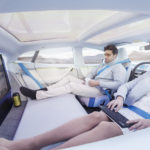 One of the more widely cited applications of the illusory superiority bias in action is the fact that most people believe themselves to be better than average drivers. It’s a finding that is often used to highlight the flawed nature of human thinking, especially when it comes to ourselves, but new research from Penn State suggests it might also hold back the advance of autonomous vehicle technology.
One of the more widely cited applications of the illusory superiority bias in action is the fact that most people believe themselves to be better than average drivers. It’s a finding that is often used to highlight the flawed nature of human thinking, especially when it comes to ourselves, but new research from Penn State suggests it might also hold back the advance of autonomous vehicle technology.
The study is the last of three pieces conducted by S. Shyam Sundar exploring how our perceptions of technology, and in particular its capabilities relative to our own, affects our willingness to use it. Whereas in the two previous works, he explored how the ‘machine heuristic’ affects acceptance of AI-driven medicine and our willingness to divulge private information to technology, his latest explores whether our perceptions of the ability of autonomous vehicles relative to our own driving abilities might hinder the adoption of driverless technology.
The study found that people who believed that machines can outperform humans in general, were subsequently considerably more likely to accept the presence of autonomous vehicles on our roads.
“There are two camps — one camp is very strongly in favor of these kinds of smart technologies, such as self-driving cars, and the other, which has grave concerns about giving control to machines, especially for vital tasks like this,” the researchers say.
Faith in tech
It results in the perhaps unsurprising finding that a belief in the ability of autonomous technology goes hand in hand with support for this technology on the roads today. In other words, the greater the belief that technology can outperform human drivers, the more willing people are to have machines driving cars for us.
The research found that this fundamental belief in the power of the technology was twice as indicative of acceptance as things such as the coolness of the technology or support for technology in general. The authors suggest that their findings might influence how car companies design the cars, especially the interiors as things like steering wheels could be removed and the space put to better use.
“Designers may need to think in a different way, for example there’s no need to design in-car and dashboard interfaces based on what a human driver would normally use,” they explain. “Keep in mind, the participants also say they like the agency and convenience of autonomous vehicles and they do like the fun aspect as well, so the designer might want to add features on the dashboard that can bump up those things, including gamifying the transportation experience.”
The interior could also be designed to include a higher level of human interaction in the vehicle and improve communication both between the passengers and the vehicle, and indeed with other vehicles. For instance, a GUI could include information that helps to locate the vehicle in relation to the entire transportation system or to allow the passenger to signal their intent.
It’s possible that the removal of traditional design features can enhance the sense of danger for passengers, but if design features can rebuild the agency of the passenger then this need not be the case.
The acceptance of technology has a long history, with many new technologies accompanied by scepticism by the ability of the technology to match or surpass that of humans. Just as acceptance typically grows as evidence comes in about the performance of the technology, the researchers believe the same will occur with autonomous technologies.